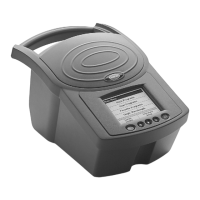Laboratory Practices
Laboratory Practices
5940022LabPrac.fm Page 25
2.12 Achieving Accuracy in Volume Measurement
2.12.1 Pipets and Graduated Cylinders
When smaller sample quantities are used, the accuracy of measurements
becomes increasingly important. Figure 7 illustrates the proper way to read the
sample level using the meniscus formed when the liquid wets the cylinder or
pipet walls.
Figure 7 Reading the Meniscus
Before filling, rinse the pipet or cylinder two or three times with the sample to be
tested. Use a pipet filler or pipet bulb to draw the sample into the pipet.
Never pipet chemical reagent solutions or samples by mouth. When filling a
pipet, keep the tip of the pipet below the surface of the sample as the sample is
drawn into the pipet.
Serological pipets have marks that indicate the volume of liquid delivered by the
pipet. The marks may extend to the tip of the pipet or may be only on the
straight portion of the tube. If the marks are only on the straight part of the tube,
fill serological pipets to the zero mark and discharge the sample by draining the
sample until the meniscus is level with the desired mark. If the serological pipet
has marks extending to the tip of the pipet, fill the pipet to the desired volume
and drain all the sample from the pipet. Blow the sample out of the pipet tip for
accurate measurements.
Volumetric (transfer) pipets have a bulb in the middle and a single ring above
the bulb to indicate the volume of liquid when it is filled to the mark. To
discharge a volumetric pipet, hold the tip of the pipet at a slight angle against the
container wall and drain. Do not discharge the solution remaining in the tip of
the pipet after draining. Volumetric pipets are designed to retain a small amount
of sample in the pipet tip.
If droplets of sample cling to the walls of the pipet, the pipet is dirty and is not
delivering the correct amount of sample. Wash the pipet thoroughly with a
laboratory detergent or cleaning solution and rinse several times with
deionized water.
2.12.2 The Pour-Thru Cell
The Pour-Thru Cell is an optional accessory that improves accuracy and makes
measuring more convenient, especially when the analyte is present at low levels.
Using the Pour-Thru Cell avoids any error that might result from optical
differences between sample cells. See your Instrument Manual for instructions on
installation. Not all procedures allow for using the Cell. The Pour-Thru Cell can
be used with Hach chemistries provided a 25 mL sample is analyzed. Exceptions
are noted in Tab le 6.
45
50
40

